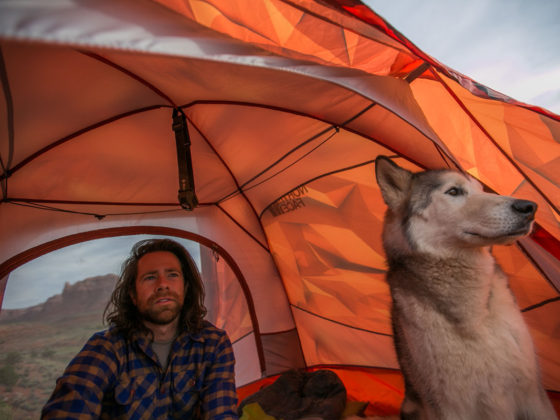LEARNING TO SET UP a super comfortable and secure — as I like to say, “bomber” — camp is one of the most rewarding skills progressions there is. A certain quiet confidence comes over you when you’re able to quickly build snug camps even when (and especially when) conditions turn.
I’m talking about those late August afternoons in the Rockies when the air cracks and huge thunderstorms — even hail and ice — start pounding your tent. Meanwhile you’re tucked in your bag reading Ed Abbey, drinking tea, and grinning ear to ear. Or staying cool midday in Baja Mexico because you knew to set up a sun shelter — and likewise how to batten it down, keeping it from blowing out to sea when the offshores start ripping after nightfall.
The lessons I’m about to share come from over 30 years of camping in nearly every conceivable terrain in the Americas, from snow camps at 15,000 feet on Volcán Cotopaxi to winter camps along the Appalachian Trail to summer nights under the stars deep in Southern river gorges.
My experience is from the old school. As a kid I went to Camp Mondamin in Tuxedo, North Carolina, famous as a breeding ground for Olympic whitewater paddlers and burly climbers. I have memories of counselors holding up grommet-less sheets of plastic, then showing us how to wad up dirt and leaves, sticking them into the corners of the sheet so as to form tiny anchors we could tie our parachute cord to. That was our shelter.
And while the following lessons won’t go quite to those extremes, it’s all rooted in the same basic principle: Proper camping, like surfing, kayaking, or any other outdoor skills progression, is all an extension of “reading” the terrain. It’s about developing a certain awareness, a relationship with the place and conditions.
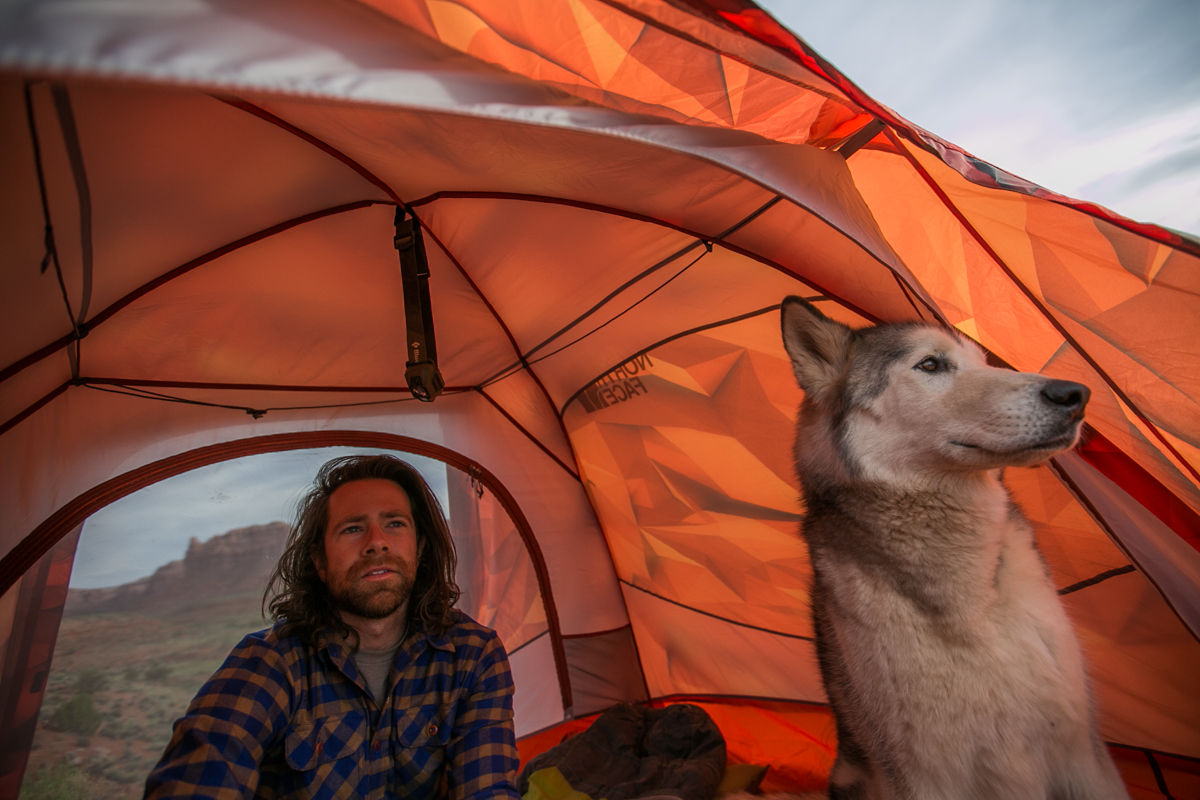
Beyond the gear and the place itself, a good camp is all about who you’re with. Kelly Lund and Loki the Wolfdog in the high desert. Photo: Scott Sporleder.
1. Choose the safest, best natural site for your given terrain and conditions — then enhance it.
Whether you’re deep in backcountry or at an organized campground, where and how you place your tent says a lot about how in tune you are with your surroundings. For example:
- Did you take into consideration where the morning sun will rise, providing welcome warmth in cool forested areas (or perhaps the opposite — unwelcome early hours of heat in desert environments)?
- If in a windy place, did you leave your tent on an exposed ridgeline or in an open meadow? Or did you look for a natural “lee” or wind-shelter such as a rock formation, band of trees, or simply the leeward side of a hill?
In mountainous terrain
The mountains give a grand, open, “majestic” feel to camping. In the summer months they’re often the coolest, most naturally comfortable place to be as well. Except in the most arid regions, mountains also mean water — places to find canyons, creeks, springs.
The best mountain campsites are often found on saddles. As opposed to the high points of a ridgeline (typically the most weather-exposed places), or deep in the valley (often the wettest / buggiest areas) saddles tend to be more protected, while at the same time giving a good, elevated position over much of the surrounding landscape. Especially solid setups are small “fingers” of land that jut from hillsides where the land falls steeply away on either side.
Snow camping
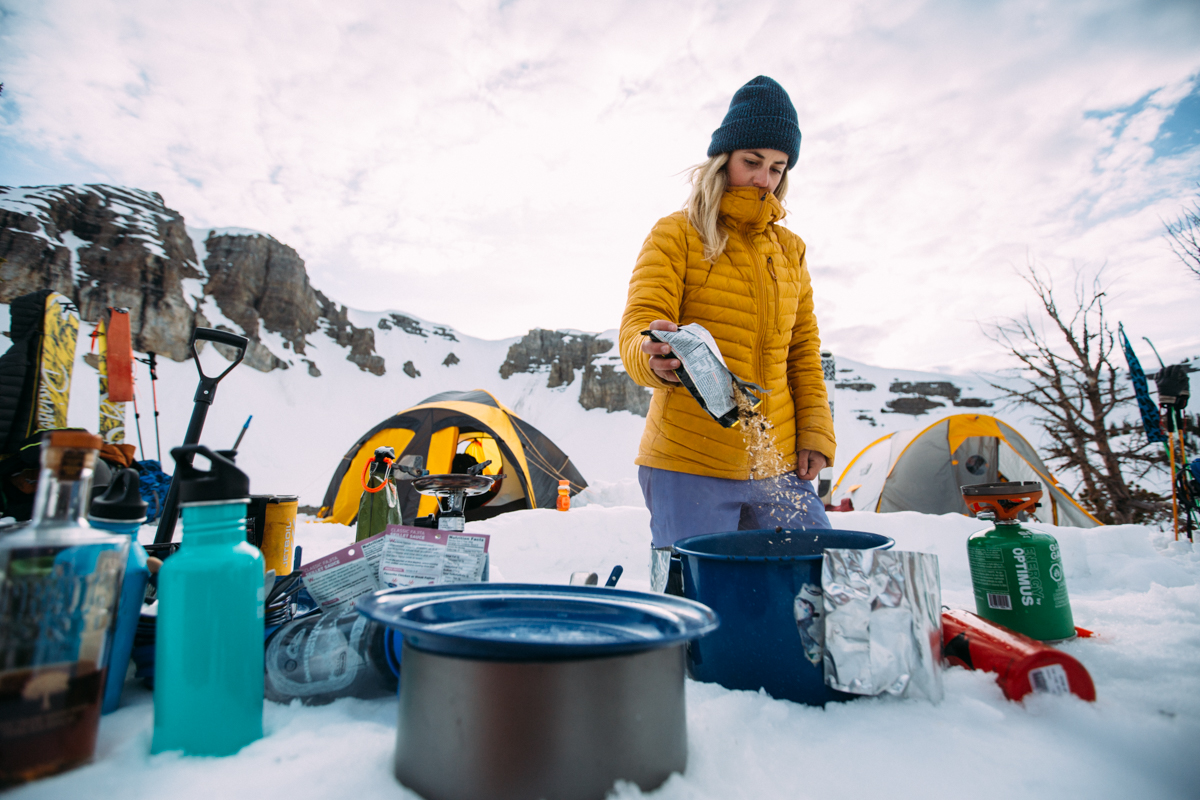
Even snow camping can be super comfortable with the right setup. Here, our crew has a nice snow bench / table dug out. A small piece of plywood as a table top would’ve come in handy, but as it was a short, ultra light trip into the backcountry, they were still loving life. Photo: Scott Sporleder
Snow camping can create some of the most peaceful and quiet moments you’ve ever had. Compared to other forms of camping, creating shelter in the snow has a strong sense of “burrowing,” especially if fresh snow continues to fall overnight and you awake to a landscape completely reset — all of yesterday’s tracks now covered.
In extremely mountainous terrain such as Alaska or the Rockies, the most secure snow camps are built in the the center of the valley floor, far past any possible avalanche run-out. As mentioned above, saddles also provide another optimal location.
Humid, forested terrain (Eastern US)
Camping in the forest has an enchanted feel. Nearby trees and plants become part of your kitchen, living room. You begin to notice sounds, smells; there’s an intimacy to the terrain.
The most rewarding campsites are often found perched above rivers — look for broad sandy beaches along the river-bends. Another good place is at the base of a steep slope. Like camping by a river, these transition areas from steep to flat terrain typically create a gap or clearing, some open space in the canopy to observe wildlife and the terrain around you.
The biggest challenge for staying comfortable when camping in heavily forested terrain such as the Appalachian Mountains is keeping dry. Although a bomber shelter is mandatory, it’s just as important to learn to “think like water.” As you survey a potential site, what signs of erosion do you see? How high is the land you want to camp on compared to the surrounding area? Are you basically camping in a future puddle? Or is there a natural drain of sorts, a gully or trail that water would naturally follow instead of pooling up around your tent?
Dry, sandy conditions (beach or desert)
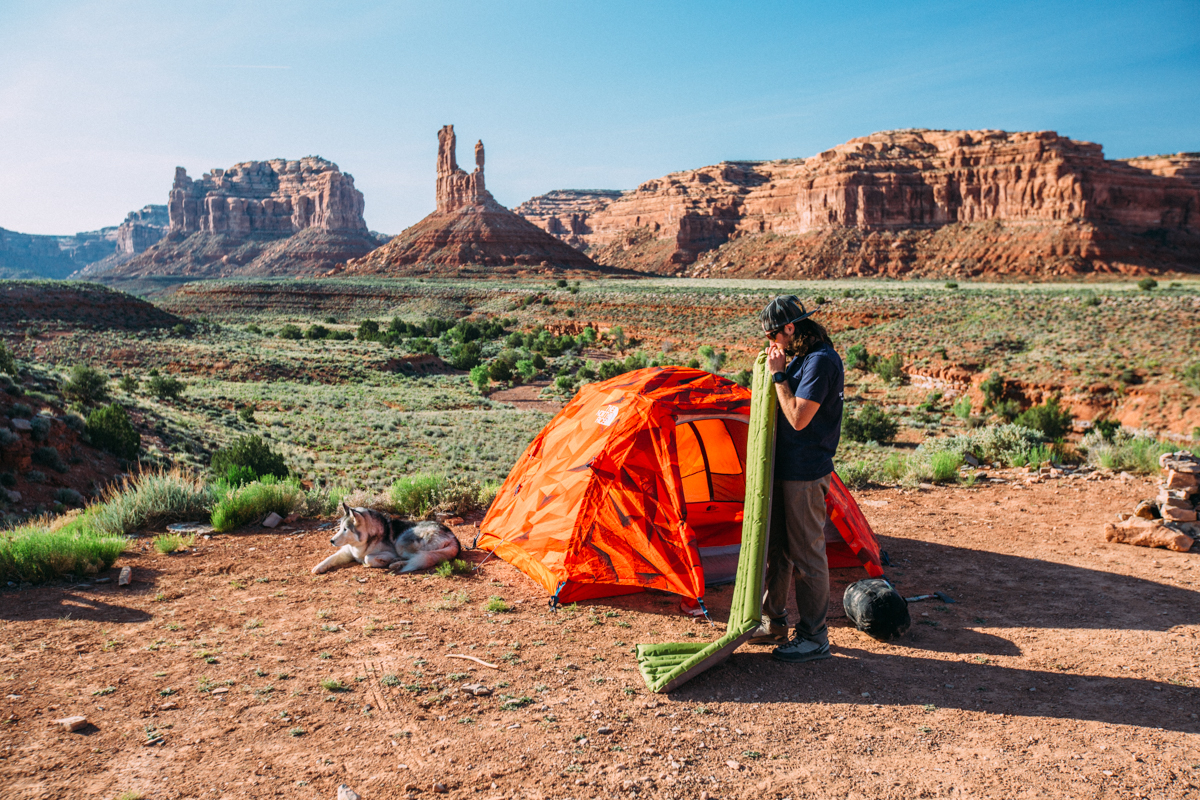
Kelly Lund setting up in classic high desert terrain in southern Utah. The sage scrublands along these valley floors make for some of the most aromatic camping experiences you’ll ever have. Image by Scott Sporleder.
Camping in desert or beach environments is often some of the most naturally comfortable (dry, low humidity), as long as you factor in shelter from the sun. Tents do not work as sun shelter; they become ovens. Instead, make sure to bring a tarp shelter (as we’ll discuss below).
Another issue you’ll face while camping in sandy conditions is having sand blow into your food / kitchen. The simplest way to overcome this is to elevate your cooking area and food stores off the ground. We’ll discuss this in the section on kitchen prep below.
2. Beyond your tent, always carry a tarp or tarp shelter (as big as possible), and get creative with it.
We’ll go into many specific pieces of gear for better camping below, but a tarp shelter needs its own special section. The reason is this: Camps are meant to be inhabited, truly lived in, not just places to sleep. Whereas tents make great sleeping spaces, you typically usually can’t stand up in them, cook in them, set up chairs in them, etc. Enter the tarp shelter.
Tarp shelters can go from pre-made shelters with poles and tie-downs to simple tarps that you set up with para-cord like the one I carried on the Appalachian Trail as an emergency shelter. Besides being able to use it on occasion as my “tent” (setting it up with center line strung down the middle, tied between trees), having a tarp served another key purpose. During particularly strong winter weather events such as ice storms, being able to “tarp off” the front of shelters is the difference between riding out the storm and still having a dry sleeping bag in the morning, vs. having to retreat to the nearest town to dry out all your gear.
A well-strung tarp simply makes the space around your camp more comfortable, homey. It can serve as the central gathering place, the kitchen, the front porch, the lounge, the garage, the shade.
More tips:
- Set your shelter over a picnic table.
- To create a front porch / cooking area, set up over the front half of your tent, thus extending the vestibule several feet.
- Park two vehicles with roof-racks beside each other, leaving a gap of 10-12 feet between them, then tie the tarp between the roof-racks. This is a great setup when camping at festivals and other places where there are lots of vehicles.
3. Adapt your camp for maximum comfort, and keep it clean!
Having an uncomfortable sleeping spot can take the fun out of an otherwise great camping setup. It’s so easy to take just a few moments to ensure you like where you’re going to sleep, and yet oftentimes campers simply set up their tent in one location and keep it there the whole time, as if on a permanent foundation. One of the best features of a freestanding tent is that, after setting up the poles, as long as you don’t stake it down you can easily pick it up and move it around, playing with different angles and positions. And realistically, you don’t even need to stake down your tent until there is wind / rain.
So before pounding in stakes, test out your sleeping spot. Lie down on your pad and pivot and slide it around until you find the most comfortable position. Then place your tent on top of the pad, and slide it back out from under.
Here’s another hack with freestanding tents: Open the door, pick it up overhead, flip it upside down, and shake out all the debris and dust. Then, with the tent newly cleaned, re-organize your sleeping stuff — bags, pads, headlamp, water bottle. You’ll sleep better in a clean and well-organized space.
4. Create a workspace and a clean “kitchen.”
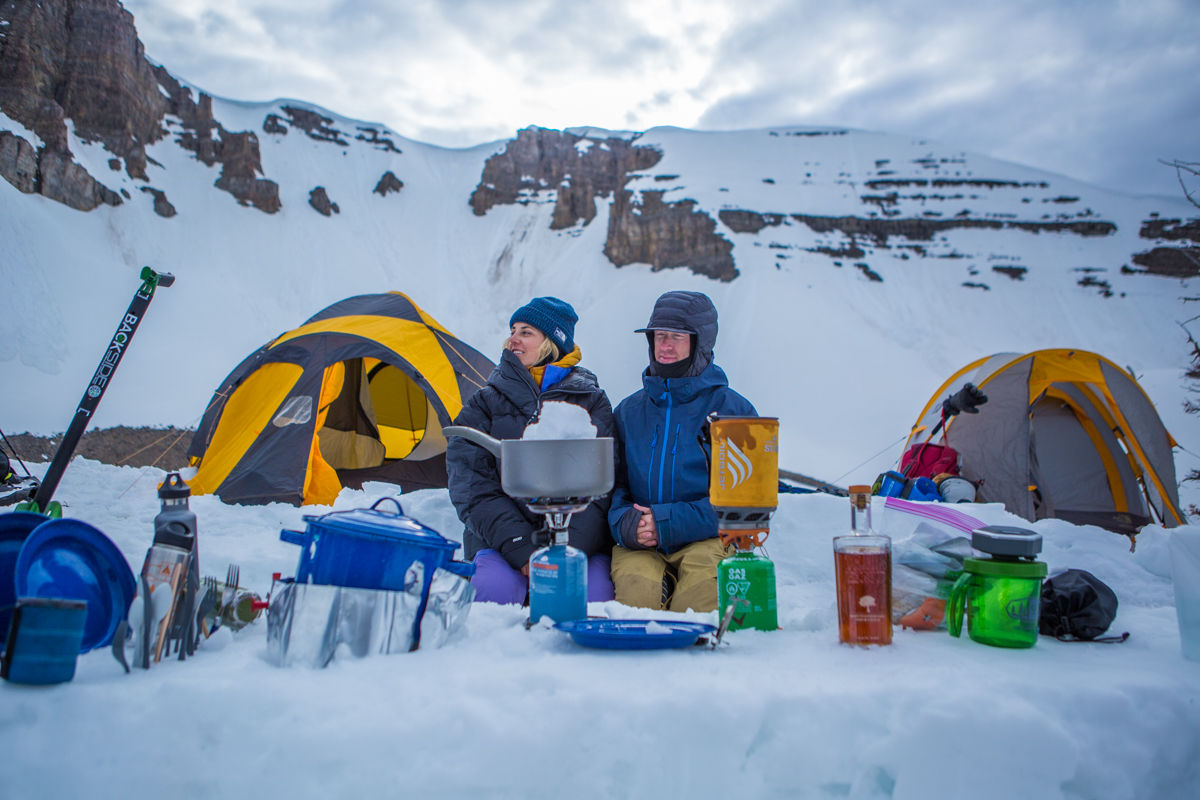
Photo: Scott Sporleder
Besides a secondary shelter, one item that can make a huge difference in the comfort level of your camping — especially backcountry camping — is a camp table. Preparing food on the ground can be awkward; you tend to get dirt and sand in your food. And in cold environments, placing pots on the ground also cools them off quickly.
As with tarp shelters, camp tables have come a long way. There are tiny, lightweight backcountry models that will revolutionize how you set up your kitchen. That said, there’s always raw ingenuity. Even if you don’t have a camp table, try to set up an elevated workspace with whatever’s at hand. In the past I’ve done everything from setting a flipped-over surfboard on top of stacks of driftwood to rolling a yoga mat on top of rocks.
If you’re camping in snow, one simple but key gear choice: a piece of plywood. Even just a single or pair of two-foot-long by 16-inch-wide pieces of laminate or plywood (you can cut out a template that fits into your backpack) makes a huge difference by allowing you to set up a tabletop instead of just having your kitchen sitting on snow. And if you’re truly going solo ultra ultralight, just remember to take a frisbee — it serves as your all in one backcountry cutting board, plate, and wash station (and evening entertainment).
5. Don’t forget these pieces of gear that will make everything flow more smoothly.
Clothesline – Who wants their gear scattered and damp? A clothesline is the simplest piece of camp furniture you can create. Just bring extra para cord. Keep your clothes and gear aired out and organized.
LED lantern – Sure, everyone has headlamps, but what about some simple ambient lighting? A lantern can add a surprising degree of comfort, particularly if you’re camping with young children. Hang it from the inside of your tent or under your secondary shelter. Or just hang a headlamp (you brought a backup, right?).
Food storage containers – You don’t want to deal with rodents or other animals in the middle of the night. All campers should take a lesson from those who camp in bear country. There, especially in national parks, you’ll often see signs reminding that “Garbage kills bears.” Animals who get accustomed to human food / trash lose their instincts to forage; bears who learn to raid campsites for food often must be relocated or exterminated. Over the years, I’ve done everything from hanging bear bags to creating my own critter-proof plastic boxes. The easiest option, though, is purchasing a ready-made food storage container and having peace of mind that some raccoon isn’t ransacking next morning’s oatmeal — and vice versa, that you’re not impacting the local environment by introducing human food.
Hammocks – What’s a camp without a place to just hang outside taking in the view? New school nylon hammocks like those by ENO have the highest “comfort to weight” ratio of any single piece of gear you can bring — think of them as your backcountry “sofa.”
6. Center your camp around a proper fire.
It should go without saying that gathering around a fire each night is what truly solidifies a camp, regardless of who you’re with, regardless of where you are. There’s a sense of comfort, community, and warmth a campfire provides that can’t be matched by anything you physically “bring” to your camp. I’ve written a complete 5-step guide to proper firemaking, but just to touch on a few points:
- Avoid using huge logs that will never completely burn without enormous fires. Build small, well-burning, controlled fires by having proper tinder and kindling and only burn what you need.
- Never use your fire as a trash receptacle.
- If you’re in a super dry area with a high level of fire danger, consider using a fire pan.
7. Close the circle: Leave the camp in a better-than-you-found-it state.
Why do you make sure to leave things better than you found them? Simple: so that the next group who decides to spend the night out under the stars in this special place can have as positive an experience as you did.
As with everything else we’ve talked about, breaking camp should be an exercise in observation. Even down to the area where you set up your tent — notice any traces it left and cover them with leaves and other material. Pick up any and all trash. Did you leave huge charred chunks of wood in the fire pit? If in the backcountry, can you disassemble the fire pit altogether so there’s no trace you were ever there?
Each of these little ways you pay attention will lead to new ideas of how to do it better next time. Ultimately, you’ll find yourself being super comfortable camping wherever you go.

